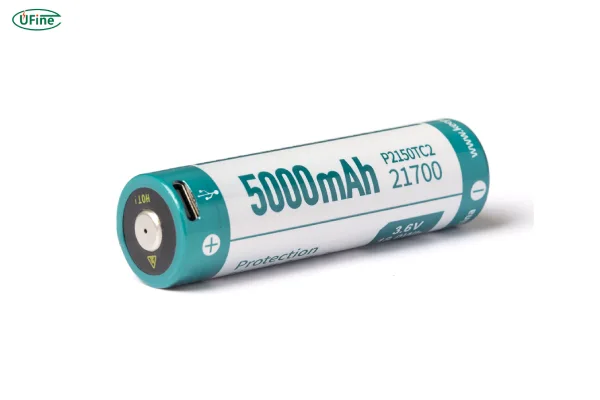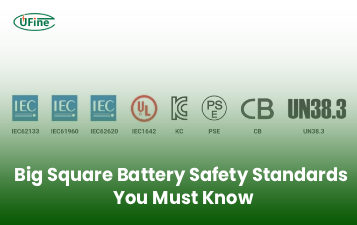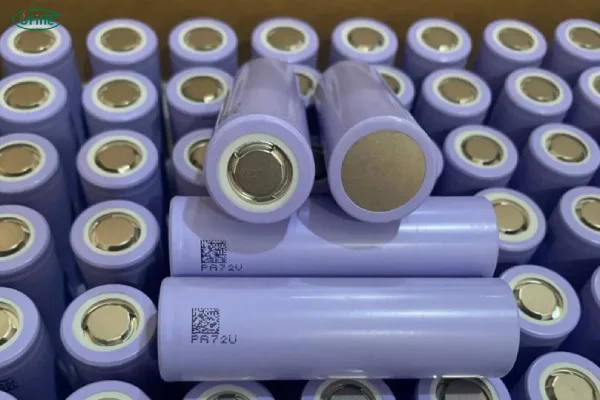
- Part 1. Learn about 21700 battery 5000mAh
- Part 2. Technical specifications of a 21700 5000mAh battery
- Part 3. Meaning of 5000mAh capacity
- Part 4. Usage time based on application types
- Part 5. Factors that affect usage time
- Part 6. Discharge rate and runtime impact
- Part 7. Cycle life: how many times can you use it?
- Part 8. Charging time and efficiency
- Part 9. Estimated usage scenarios and runtime table
- Part 10. Comparison with other battery types
- Part 11. How to maximize the life time of a 21700 battery
- Part 12. Common myths about 21700 battery runtime
- Part 13. Selecting a quality 21700 5000mAh battery
- Part 14. Final words
The 21700 lithium-ion battery has become a favored choice across multiple industries due to its excellent balance of size, energy capacity, and discharge performance. One of the most popular specifications in this category is the 21700 battery with a 5000mAh capacity. But an often-asked question is: How long can a 21700 battery 5000mAh be used?
This article offers a comprehensive, technical, and real-world explanation to help consumers and businesses understand the true performance behind these powerful cylindrical cells.
Reveal the answer first.
The answer depends on many variables: device load, ambient temperature, discharge rate, and battery quality. At a base level, a 21700 5000mAh battery stores about 18.5Wh, enough to power a 5W device for roughly 3.7 hours. With proper care and optimal usage, these batteries can serve efficiently for hundreds of cycles.
Part 1. Learn about 21700 battery 5000mAh

A 21700 battery refers to a cylindrical lithium-ion battery that measures 21mm in diameter and 70mm in length. It was designed to offer better energy density than the older 18650 format. The 5000mAh rating indicates its nominal capacity: it can supply 5000 milliamps (or 5 amps) for one hour under ideal conditions.
The 21700 battery is commonly used in:
- Electric bikes and scooters
- Flashlights
- Power tools
- Vaping devices
- Power banks
- Energy storage systems
The 21700 format is increasingly adopted by EV manufacturers and tech companies due to its higher capacity and better thermal performance compared to traditional lithium-ion cells.
Part 2. Technical specifications of a 21700 5000mAh battery
To better understand how long this battery can be used, it’s essential to grasp the technical characteristics:
- Nominal Voltage: 3.6V or 3.7V
- Fully Charged Voltage: Typically 4.2V
- Capacity: 5000mAh (5Ah)
- Energy (Watt-hours): ~18.5Wh (3.7V * 5Ah)
- Maximum Continuous Discharge Rate: Often ranges from 5A to 15A or higher for high-drain models
- Cycle Life: 300–1000+ full cycles depending on use and brand
- Charging Time: 2 to 5 hours depending on charger current
Part 3. Meaning of 5000mAh capacity
Many people misinterpret what 5000mAh truly means. It doesn’t imply the battery will power every device for the same amount of time. The real-world performance depends on the device’s power consumption.
Quick calculation:
Energy = Voltage x Capacity = 3.7V x 5Ah = 18.5Wh
This means the battery can power a device that consumes 18.5 watts for one hour. For lower power consumption devices, the runtime increases significantly.
Part 4. Usage time based on application types
Let’s examine some common applications and estimate how long a 21700 5000mAh battery can power them:
Flashlights
- High-drain flashlight: 5W → 18.5Wh / 5W = ~3.7 hours
- Low-power LED flashlight: 2W → ~9.2 hours
Vape Devices
- Power usage: 20W → ~0.9 hours (intermittent usage may last all day)
Power Banks / Smartphones
- Charging a smartphone that needs 10Wh: Almost 1.8 full charges
E-Bikes and Scooters
- Small e-bike motor: 250W → 18.5Wh / 250W = ~0.074 hours (~4.5 minutes) per cell (used in series/parallel banks)
DIY Projects
- Raspberry Pi (5V @ 2A = 10W): ~1.8 hours
Part 5. Factors that affect usage time
1. Device Power Consumption
Devices with higher wattage drain batteries faster. A motorized tool at 100W will deplete the battery much quicker than an LED light at 3W.
2. Usage Pattern
Intermittent use (e.g., vaping) extends effective usage time compared to continuous drain.
3. Ambient Temperature
Cold temperatures reduce battery efficiency and discharge capacity.
4. Battery Health
As batteries age, their capacity diminishes. A used 21700 5000mAh cell may deliver only 80% or less of its original runtime.
5. Discharge Rate Compatibility
Using a battery beyond its rated discharge limit will increase internal resistance and reduce its lifespan.
Part 6. Discharge rate and runtime impact
Discharge rate is how fast current can safely be drawn. It is usually indicated in amps or a C-rate.
- Standard cells: 5A continuous discharge
- High-performance cells: 10A–20A discharge or more
Impact on Runtime: Higher discharge rates produce more heat and can reduce usable capacity slightly. For example, a battery discharging at 15A might see a 5–10% drop in effective runtime compared to a 2A drain.
Part 7. Cycle life: how many times can you use it?
Cycle life refers to how many complete charge-discharge cycles a battery can undergo before its capacity falls below 80% of its original value.
- Standard 21700 5000mAh batteries: ~300–500 cycles
- Premium brands: Up to 1000 cycles with proper care
Factors that impact cycle life:
- Charging above 1C
- Deep discharges (below 2.5V)
- High ambient temperature use
- Poor-quality battery materials
Part 8. Charging time and efficiency
Charging speed depends on:
- Charger output (A)
- Battery’s charge acceptance
For a 21700 5000mAh battery:
- 1A charger: ~5 hours
- 2A charger: ~2.5 hours
- Fast charger (3A+): ~1.5–2 hours (if battery supports it)
Efficiency: Lithium-ion batteries are ~90–95% efficient during charging. Some energy is lost as heat.
Part 9. Estimated usage scenarios and runtime table
ApplicationPower DrawEstimated RuntimeLED Flashlight5W~3.7 hoursVape Device20W~0.9 hours (intermittent)E-bike Cell Usage250W~4.5 minutes (per cell)Power Bank Output10W~1.8 hoursRaspberry Pi 410W~1.8 hours
Note: Devices with internal boost converters or regulators may reduce effective output time due to conversion losses.
Part 10. Comparison with other battery types
21700 vs 18650
- Size: 21700 is larger
- Capacity: 5000mAh vs ~3000–3600mAh (typical 18650)
- Energy density: Higher in 21700
- Thermal management: Better in 21700 due to surface area
21700 5000mAh vs Lower Capacity 21700
- 4000mAh cells offer higher discharge rates
- 5000mAh cells favor long runtime
- Trade-off: runtime vs power output
LiFePO4 vs Li-ion
- LiFePO4 offers longer cycle life but lower energy density
- Li-ion (21700) is better suited for compact, high-capacity needs
Part 11. How to maximize the life time of a 21700 battery
- Avoid full discharge: Stop using below 3.0V when possible
- Use quality chargers: With smart cutoffs and temperature monitoring
- Store at 40–60% charge for long periods
- Keep within 10°C–35°C range during use/storage
- Don’t exceed rated discharge: Stick to device-appropriate batteries
These habits will not only increase runtime per charge but also extend the overall service life of the cell.
Part 12. Common myths about 21700 battery runtime
- “5000mAh means 5 hours of use”: Only true at 1A draw (3.7W load). Higher loads reduce runtime.
- “All 5000mAh cells are the same”: Different brands vary in efficiency, real capacity, and internal resistance.
- “Runtime = mAh only”: Voltage and device load are critical to runtime.
Part 13. Selecting a quality 21700 5000mAh battery
Not all 21700 batteries are created equal. Choosing a reputable manufacturer ensures better cycle life, safety, and accurate capacity claims.
Key selection criteria:
- Verified capacity testing
- Internal resistance data
- Consistency in discharge curves
- Presence of safety features (protection PCB, thermal cutoffs)
Ufine Battery: Custom 21700 Battery Solutions
Ufine Battery, a leading Chinese lithium battery manufacturer, specializes in producing high-quality 21700 cells, including 5000mAh configurations. With extensive expertise in custom lithium solutions, Ufine offers:
- Tailored voltage, capacity, and size options
- High-rate and high-temperature battery designs
- Fast production and delivery
- OEM & ODM manufacturing services
Ufine’s 21700 batteries are ideal for industries requiring stable, long-lasting, and efficient power sources. Whether you need cells for smart devices, tools, or energy storage systems, Ufine Battery provides professional support and technical customization. Contact us now!
Part 14. Final words
For those looking to integrate high-capacity 21700 cells into their products, partnering with a specialized manufacturer like Ufine Battery ensures not just performance, but also safety, customization, and long-term reliability.
Related Tags:
More Articles

Big Square Battery Safety Standards You Must Know
Learn key safety standards for big square batteries to avoid fire risks, shipping delays, and compliance issues in EV, industrial, and energy storage projects.
Big Square Battery Applications in Solar & Industrial Equipment
Big square batteries deliver high capacity, stable output, and long life for solar, industrial, and backup power. Explore key uses and advantages.
Big Square Battery vs Cylindrical Battery: Complete 2025 Guide for EVs, ESS & Industrial Devices
Choosing the right battery is key for designers and engineers. Compare big square vs cylindrical batteries to find the best fit for your application.
How to Choose the Right Big Square Battery for Your Device?
If you’re choosing a big square battery for EVs, solar, or mobility devices, this guide helps you pick the right solution for real-world needs.
Big Square Battery Complete Guide: Types, Uses & Buying Tips
If you are choosing a big square lithium battery for EVs, solar, RVs, or AGVs, this guide helps you select the right NMC, LFP, or LTO solution with examples.



